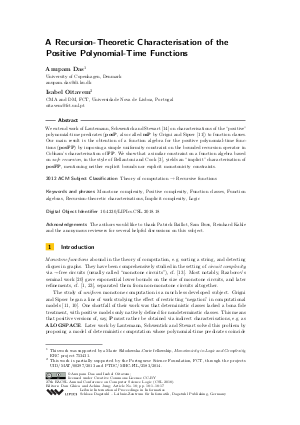A Recursion-Theoretic Characterisation of the Positive Polynomial-Time Functions
Authors Anupam Das, Isabel Oitavem
-
Part of:
Volume:
27th EACSL Annual Conference on Computer Science Logic (CSL 2018)
Part of: Series: Leibniz International Proceedings in Informatics (LIPIcs)
Part of: Conference: Computer Science Logic (CSL) - License:
 Creative Commons Attribution 3.0 Unported license
Creative Commons Attribution 3.0 Unported license
- Publication Date: 2018-08-29
File

PDF
LIPIcs.CSL.2018.18.pdf
- Filesize: 0.52 MB
- 17 pages
Document Identifiers
Subject Classification
ACM Subject Classification
- Theory of computation → Recursive functions
Keywords
- Monotone complexity
- Positive complexity
- Function classes
- Function algebras
- Recursion-theoretic characterisations
- Implicit complexity
- Logic
Metrics
- Access Statistics
-
Total Accesses (updated on a weekly basis)
0Document
0Metadata
Abstract
We extend work of Lautemann, Schwentick and Stewart [Clemens Lautemann et al., 1996] on characterisations of the "positive" polynomial-time predicates (posP, also called mP by Grigni and Sipser [Grigni and Sipser, 1992]) to function classes. Our main result is the obtention of a function algebra for the positive polynomial-time functions (posFP) by imposing a simple uniformity constraint on the bounded recursion operator in Cobham's characterisation of FP. We show that a similar constraint on a function algebra based on safe recursion, in the style of Bellantoni and Cook [Stephen Bellantoni and Stephen A. Cook, 1992], yields an "implicit" characterisation of posFP, mentioning neither explicit bounds nor explicit monotonicity constraints.
Cite As Get BibTex
Anupam Das and Isabel Oitavem. A Recursion-Theoretic Characterisation of the Positive Polynomial-Time Functions. In 27th EACSL Annual Conference on Computer Science Logic (CSL 2018). Leibniz International Proceedings in Informatics (LIPIcs), Volume 119, pp. 18:1-18:17, Schloss Dagstuhl – Leibniz-Zentrum für Informatik (2018)
https://doi.org/10.4230/LIPIcs.CSL.2018.18
BibTex
@InProceedings{das_et_al:LIPIcs.CSL.2018.18,
author = {Das, Anupam and Oitavem, Isabel},
title = {{A Recursion-Theoretic Characterisation of the Positive Polynomial-Time Functions}},
booktitle = {27th EACSL Annual Conference on Computer Science Logic (CSL 2018)},
pages = {18:1--18:17},
series = {Leibniz International Proceedings in Informatics (LIPIcs)},
ISBN = {978-3-95977-088-0},
ISSN = {1868-8969},
year = {2018},
volume = {119},
editor = {Ghica, Dan R. and Jung, Achim},
publisher = {Schloss Dagstuhl -- Leibniz-Zentrum f{\"u}r Informatik},
address = {Dagstuhl, Germany},
URL = {https://drops.dagstuhl.de/entities/document/10.4230/LIPIcs.CSL.2018.18},
URN = {urn:nbn:de:0030-drops-96851},
doi = {10.4230/LIPIcs.CSL.2018.18},
annote = {Keywords: Monotone complexity, Positive complexity, Function classes, Function algebras, Recursion-theoretic characterisations, Implicit complexity, Logic}
}
Author Details
Funding
- Das, Anupam: This work was supported by a Marie Skłodowska-Curie fellowship, Monotonicity in Logic and Complexity, ERC project 753431.
- Oitavem, Isabel: This work is partially supported by the Portuguese Science Foundation, FCT, through the projects UID/MAT/00297/2013 and PTDC/MHC-FIL/2583/2014.
References
-
Noga Alon and Ravi B Boppana. The monotone circuit complexity of boolean functions. Combinatorica, 7(1):1-22, 1987.

- David A. Mix Barrington, Neil Immerman, and Howard Straubing. On Uniformity within NC¹. J. Comput. Syst. Sci., 41(3):274-306, 1990. URL: http://dx.doi.org/10.1016/0022-0000(90)90022-D.
- Stephen Bellantoni and Stephen A. Cook. A new recursion-theoretic characterization of the polytime functions. Computational Complexity, 2:97-110, 1992. URL: http://dx.doi.org/10.1007/BF01201998.
-
Samuel R. Buss. Bounded arithmetic, volume 1 of Studies in Proof Theory. Bibliopolis, Naples, 1986.

- Peter Clote and Evangelos Kranakis. Boolean Functions and Computation Models. Texts in Theoretical Computer Science. An EATCS Series. Springer, 2002. URL: http://dx.doi.org/10.1007/978-3-662-04943-3.
-
A. Cobham. The intrinsic computational difficulty of functions. In Proc. of the International Congress for Logic, Methodology, and the Philosophy of Science, pages 24-30. Amsterdam, 1965.

-
Stephen Cook and Phuong Nguyen. Logical Foundations of Proof Complexity. Cambridge University Press, New York, NY, USA, 1st edition, 2010.

- Anupam Das. From positive and intuitionistic bounded arithmetic to monotone proof complexity. In Proceedings of the 31st Annual ACM/IEEE Symposium on Logic in Computer Science, LICS '16, New York, NY, USA, July 5-8, 2016, pages 126-135, 2016. URL: http://dx.doi.org/10.1145/2933575.2934570.
-
Fernando Ferreira. Polynomial time computable arithmetic. In Contemporary Mathematics, volume 106, pages 137-156. AMS, 1990.

-
Michelangelo Grigni. Structure in monotone complexity. PhD thesis, Duke University, 1991.

-
Michelangelo Grigni and Michael Sipser. Monotone complexity. In London Mathematical Society Symposium on Boolean Function Complexity, New York, NY, USA, 1992. Cambridge University Press.

-
Andrzej Grzegorczyk. Some classes of recursive functions. Instytut Matematyczny Polskiej Akademi Nauk, 1953.

-
A D Korshunov. Monotone boolean functions. Russian Mathematical Surveys, 58(5), 2003.

-
Clemens Lautemann, Thomas Schwentick, and Iain A. Stewart. On positive P. In IEEE Conference on Computational Complexity '96, 1996.

- Clemens Lautemann, Thomas Schwentick, and Iain A. Stewart. Positive versions of polynomial time. Inf. Comput., 147(2):145-170, 1998. URL: http://dx.doi.org/10.1006/inco.1998.2742.
- Daniel Leivant. A foundational delineation of computational feasiblity. In Proceedings of the Sixth Annual Symposium on Logic in Computer Science (LICS '91), Amsterdam, The Netherlands, July 15-18, 1991, pages 2-11, 1991. URL: http://dx.doi.org/10.1109/LICS.1991.151625.
- Daniel Leivant. A foundational delineation of poly-time. Inf. Comput., 110(2):391-420, 1994. URL: http://dx.doi.org/10.1006/inco.1994.1038.
-
Isabel Oitavem. New recursive characterizations of the elementary functions and the functions computable in polynomial space. Revista Matematica de la Universidad Complutense de Madrid, 10(1):109-125, 1997.

-
Christos H. Papadimitriou. Computational complexity. Academic Internet Publ., 2007.

-
A. A. Razborov. Lower bounds on the monotone complexity of some Boolean functions. Doklady Akademii Nauk SSSR, 285, 1985.

-
Robert W. Ritchie. Classes of predictably computable functions. Journal of Symbolic Logic, 28(3):252-253, 1963.

- Walter L. Ruzzo. On uniform circuit complexity. J. Comput. Syst. Sci., 22(3):365-383, 1981. URL: http://dx.doi.org/10.1016/0022-0000(81)90038-6.
-
E. Tardos. The gap between monotone and non-monotone circuit complexity is exponential. Combinatorica, 8(1):141-142, 1988.

- Celia Wrathall. Complete sets and the polynomial-time hierarchy. Theor. Comput. Sci., 3(1):23-33, 1976. URL: http://dx.doi.org/10.1016/0304-3975(76)90062-1.
